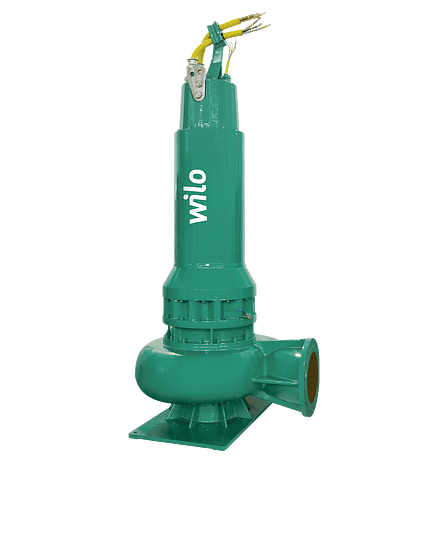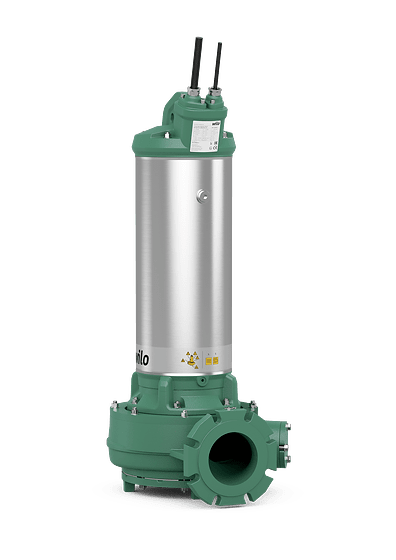Submersible Wastewater Pump Basics
A submersible wastewater pump is a specialized type of pump designed to operate fully submerged in the liquid it is pumping, typically in wastewater or sewage. These pumps are built to handle tough jobs, like moving water with solids, debris, or waste. This makes them vital for sewage treatment plants, industrial wastewater systems, and managing floods. Because they work submerged, they don’t need to be primed, use less energy, and run quietly, even in demanding situations.
What is a Submersible Pump
Defined by the Hydraulic Institute as a “single-stage, overhung [centrifugal] pump, the pump is closed coupled to a submersible electric motor and can be of either diffuser type or volute type.”

Unlike other pumps that sit above the liquid, submersible pumps work directly within it, efficiently pushing the fluid to the surface. Submersible pumps are typically designed as a close-coupled units, meaning the pump and motor share the same shaft and the motor is sealed in a watertight unit to keep the liquid out. The motor's bearings handle all the pump's thrust loads, and the pump and motor are precisely aligned and assembled as a single, compact unit.
Volute vs Diffuser in Submersible Pumps
Hydraulic Institute categorizes submersible pumps by how they manage fluid leaving the impeller: through a volute or a diffuser. Both components convert kinetic energy (velocity) into pressure but differ in design, performance, and application.
- Volute: A spiral-shaped casing that expands gradually to slow down fluid and direct it to the discharge. Volutes are ideal for wastewater and sewage applications, as they handle solids and slurries effectively and are more tolerant of wear and clogging.
- Diffuser: A ring of stationary vanes that guide and decelerate the fluid more uniformly than a volute. Diffusers offer higher efficiency and pressure, making them well-suited for clean water, deep well pumping, irrigation, and other high-head applications.
Further discussion in this fact sheet will focus on the volute type submersible (sewage) pumps used in solids handling applications and wastewater management.

Key Components
Each component works together to ensure the submersible wastewater pump operates reliably in challenging environments, whether handling clean water, sewage, or slurry.
- Motor with cooling shroud (for dry-well installation)
- Enclosed, waterproof motor that powers the pump.
- Typically, an electric motor, designed to operate underwater without overheating.
- Pump Casing
- A robust, watertight shell that protects internal components from liquid ingress and corrosion.
- Impeller
- The rotating part that generates kinetic energy to move the liquid.
- Can be open, semi-open, or enclosed, depending on the type of fluid and solids content.
- Seal System
- Prevents fluid from entering the motor compartment.
- Often includes mechanical seals and O-rings for reliability.
- Suction (Inlet)
- The opening where the liquid enters the pump.
- Typically fitted with a screen to filter out large debris.
- Discharge (Outlet)
- The port through which the pumped fluid exits.
- Designed for connection to pipes or hoses to direct the fluid.
- Bearings
- Support the rotating shaft and reduce friction, ensuring smooth operation.
- Shaft
- Connects the motor to the impeller, transmitting power to generate fluid movement.
- Electrical Cable
- Supplies power to the motor, insulated to prevent damage in wet environments.
- Often equipped with strain relief to avoid stress on connections.
- Float Switch (Optional, not shown)
- A sensor that automatically turns the pump on or off based on the fluid level.
- Cooling System (not identified)
- Some submersible pumps have built-in cooling jackets or use the surrounding fluid to prevent overheating.

Operating Principles
Like all centrifugal pumps, submersible wastewater pumps operate based on the principles of centrifugal force. In a submersible wastewater pump, fluid is drawn into the suction (inlet) and then enters the impeller. As the impeller rotates, it imparts energy to the fluid, causing it to move radially outward, creating a low-pressure area at the eye of the impeller that continuously draws in more fluid. The fluid is then pushed outwards toward the outer edges of the impeller and exits at a higher pressure through the discharge (outlet).
Even though a submersible wastewater pump is a type of centrifugal pump, it differs from other centrifugal pumps primarily in design, installation, and application.


Cooling System
Submersible wastewater pumps utilize two main types of cooling systems to prevent the motor from overheating during operation: Passive (surfaced cooled) and active (self-cooling) cooling systems.
The passive cooling system is the simplest motor technology, designed exclusively for wet-pit installations. Motors using this system feature a single air-filled chamber without a cooling shroud. Cooling occurs as the pumped fluid absorbs the motor's waste heat, which is transferred directly through the motor casing to the surrounding liquid. This straightforward and efficient method is effective if the pump remains fully submerged, allowing the liquid to naturally dissipate the heat generated by the motor.
In contrast, jacket-cooled systems use an enclosed cooling jacket around the motor, through which a separate cooling fluid circulates. This design ensures consistent cooling, even if the pump operates in low-liquid levels or dry conditions. Each cooling system is tailored to specific application needs, ensuring reliable performance and extended pump life.

Installation
Different types of installations are used for submersible wastewater pump systems in municipal and industrial applications. In water management systems, pumps can be installed in either wet-pit or dry-pit configurations. These setups differ significantly in design, operation, and suitability for specific applications.
With wet-pit installations, the pumps are submerged in the liquid being pumped, typically located in a pit (or wet well). The motor is cooled through passive cooling, relying on the surrounding pumped liquid to absorb and dissipate heat directly from the motor casing.
While submersible pumps are designed to be operated while submerged, in some applications the units are installed in a dry environment called a dry-pit. A dry-pit submersible pump is installed in a dry, easily accessible area near the liquid source, typically within a pump room or enclosure adjacent to the liquid being pumped. Dry-pit submersibles can also be located outside in the elements with no enclosure. Unlike wet-pit installations where pumps are submerged, dry-pit setups rely on active cooling systems, such as encapsulated motor with closed-circuit cooling, to manage heat effectively without direct liquid immersion.
Applications
Submersible wastewater pumps are utilized in various industries and for multiple purposes. Submersible wastewater pumps are most suited for use at municipal wastewater and wet well lift stations, where a high number of ragging issues and other contaminants including solids persist. Submersible pumps are also used in drainage/dewatering, wastewater, drinking water and food and industrial markets (diffuser type submersible pumps), but may also be used in processes where the application could require special materials or coatings.
- Municipal: Used in wastewater treatment plants, lift stations, stormwater management, and flood control systems.
- Industrial: Ideal for process water, effluent discharge, chemical transfer, and sump drainage in manufacturing and processing facilities.
- Residential: Common in basement sump systems, well water supply, septic systems, and small-scale irrigation.
- Mining: Applied in dewatering, slurry handling, and process water transfer in underground and surface operations.
- Agriculture: Used for irrigation, livestock watering, drainage, and transferring fertilizers or nutrient-rich water.
Advantages of Submersible Wastewater Pumps
- Energy Efficiency: Operates underwater, reducing energy loss in suction.
- Space-Saving Design: Compact and requires minimal installation space.
- Quiet Operation: Submerged positioning muffles operational noise.
- Durability: Resistant to corrosion and wear, suitable for harsh environments.
- Ease of Use: Requires no priming and can pump fluids with solids.
Limitations of Submersible Wastewater Pumps
Despite their numerous advantages, submersible pumps have some drawbacks:
- Maintenance Challenges: May require removal from the fluid for repairs or inspection.
- Higher Initial Costs: Typically, more expensive than external pumps.
- Accessibility Issues: Submerged location can make troubleshooting more difficult.
Considerations for the Use of Submersible Wastewater Pumps
- Fluid type being pump and characteristics (clean water, wastewater, or slurry).Installation environment (depth, accessibility, application). Desired flow rate and pressure head.
- Power requirements and energy efficiency.
- Pump materials and compatibility with corrosive or abrasive substances.
Submersible pumps are a type of centrifugal pump designed to operate while fully submerged in the fluid they are moving. These pumps play a vital role in modern society by enabling the safe and efficient transport of water, wastewater, and other fluids in critical systems. From municipal sewage treatment and stormwater management to agricultural irrigation, industrial processing, and residential well water supply, submersible pumps support essential infrastructure that protects public health, supports food production, drives industry, and manages natural resources.
Wilo is Your Solutions Provider
Wilo is a trusted solutions provider for solids handling applications and submersible sewage pumps, offering innovative technologies designed to meet the toughest challenges in wastewater management. From raw sewage and sludge to stormwater with high solids content, Wilo’s pumps are engineered for durability, efficiency, and clog-free performance. With specialized hydraulic designs, rugged materials, and advanced motor cooling systems, Wilo ensures reliable operation in demanding environments. Whether for municipal, industrial, or infrastructure projects, Wilo delivers comprehensive pumping solutions that support long-term system performance and sustainability.
Wilo Submersible Wastewater Offerings
-

Wilo-Rexa SUPRA
-

Wilo-FA
-

Wilo-Rexa SOLID


